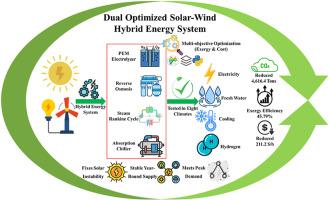Thermoeconomic optimization of climate-adaptive solar and wind multi-generation systems using artificial intelligence and thermal energy recovery
IF 8
2区 计算机科学
Q1 AUTOMATION & CONTROL SYSTEMS
Engineering Applications of Artificial Intelligence
Pub Date : 2025-09-30
DOI:10.1016/j.engappai.2025.112481
引用次数: 0
Abstract
This study presents a hybrid multi-generation energy system designed to overcome solar intermittency while meeting the global demand for integrated delivery of electricity, water, cooling, and sustainable fuels in the transition to decarbonization. The engineering application integrates solar thermal and wind energy with a modified Brayton cycle, a Steam Rankine Cycle (SRC), and a Thermoelectric Generator (TEG) to simultaneously produce electricity, fresh water via Reverse Osmosis (RO), hydrogen and oxygen via Proton Exchange Membrane Electrolyzer (PEME), and cooling (via absorption chiller) within a unified optimization framework. The system was modeled using Engineering Equation Solver (EES) and optimized via Response Surface Methodology (RSM) based on 11 decision variables. To address the complexity of optimization, a second phase applied Artificial Intelligence (AI) techniques: Adaptive Boosting (AdaBoost) for predictive modelling and Particle Swarm Optimization (PSO) for global optimization. Under optimal conditions, the Response Surface Methodology yielded an exergy efficiency of 45.8 % with a cost rate of 576.76 United States Dollars per hour (USD/h), while AI reduced costs to 211.2 USD/h with a moderate efficiency trade-off. Simulation of the optimized configuration across eight diverse climates identified Quebec as most viable, generating 22,629.6 Megawatt-hours per year (MWh/year) of electricity and avoiding 4616.4 tons of Carbon Dioxide (CO2) emissions annually. Integration of wind energy stabilizes solar variability, enhancing performance. AI contributes to optimizing complex interactions, nonlinear constraints, and multiple conflicting objectives. The methodology offers a scalable, generalizable framework for designing intelligent, climate-resilient infrastructures. Future research includes AI-enabled real-time control, experimental validation, and broader deployment strategies.

基于人工智能和热能回收的气候适应性太阳能和风能多发电系统热经济优化
本研究提出了一种混合多发电系统,旨在克服太阳能的间歇性,同时满足全球在向脱碳过渡过程中对电力、水、冷却和可持续燃料的综合输送的需求。该工程应用程序将太阳能热能和风能与改进的布雷顿循环、蒸汽朗肯循环(SRC)和热电发生器(TEG)结合在一起,在统一的优化框架内同时产生电力、通过反渗透(RO)产生淡水、通过质子交换膜电解槽(PEME)产生氢气和氧气,并通过吸收式冷却器进行冷却。采用工程方程求解器(EES)对系统进行建模,并基于11个决策变量,采用响应面法(RSM)对系统进行优化。为了解决优化的复杂性,第二阶段应用了人工智能(AI)技术:用于预测建模的自适应增强(AdaBoost)和用于全局优化的粒子群优化(PSO)。在最佳条件下,响应面法的火用效率为45.8%,成本率为每小时576.76美元(USD/h),而人工智能将成本降至211.2美元/小时,效率折衷适中。对八种不同气候条件下优化配置的模拟表明,魁北克是最可行的,每年产生22,629.6兆瓦时(MWh/年)的电力,每年避免4616.4吨二氧化碳(CO2)排放。风能的整合稳定了太阳能的可变性,提高了性能。人工智能有助于优化复杂的交互、非线性约束和多个相互冲突的目标。该方法为设计智能、气候适应性强的基础设施提供了一个可扩展、可推广的框架。未来的研究包括人工智能实时控制、实验验证和更广泛的部署策略。
本文章由计算机程序翻译,如有差异,请以英文原文为准。
求助全文
约1分钟内获得全文
求助全文
来源期刊

Engineering Applications of Artificial Intelligence
工程技术-工程:电子与电气
CiteScore
9.60
自引率
10.00%
发文量
505
审稿时长
68 days
期刊介绍:
Artificial Intelligence (AI) is pivotal in driving the fourth industrial revolution, witnessing remarkable advancements across various machine learning methodologies. AI techniques have become indispensable tools for practicing engineers, enabling them to tackle previously insurmountable challenges. Engineering Applications of Artificial Intelligence serves as a global platform for the swift dissemination of research elucidating the practical application of AI methods across all engineering disciplines. Submitted papers are expected to present novel aspects of AI utilized in real-world engineering applications, validated using publicly available datasets to ensure the replicability of research outcomes. Join us in exploring the transformative potential of AI in engineering.
 求助内容:
求助内容: 应助结果提醒方式:
应助结果提醒方式:


